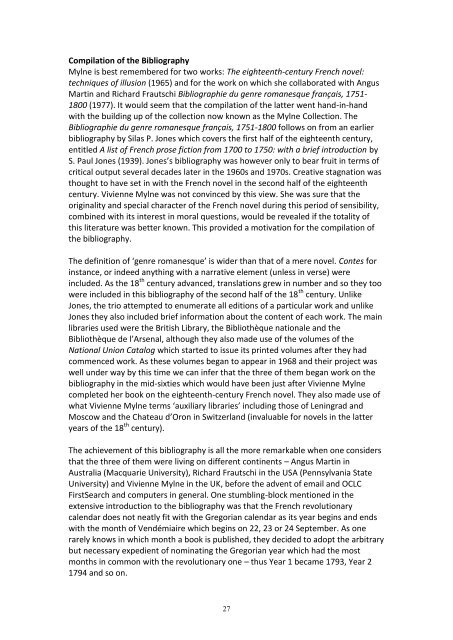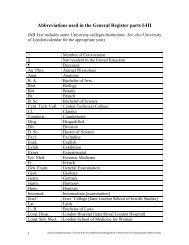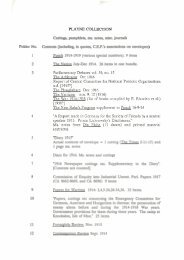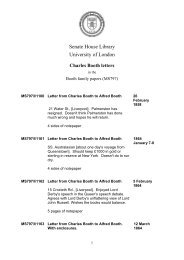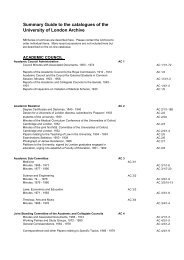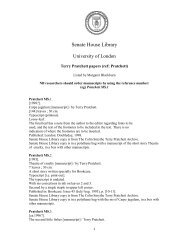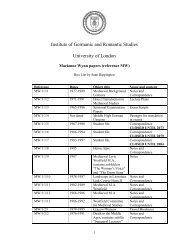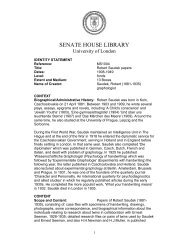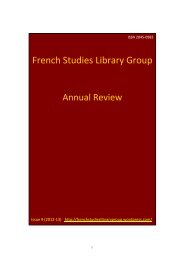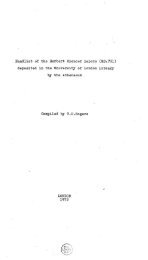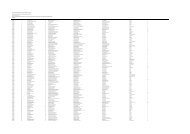FSLG Annual Review - Senate House Libraries - University of London
FSLG Annual Review - Senate House Libraries - University of London
FSLG Annual Review - Senate House Libraries - University of London
You also want an ePaper? Increase the reach of your titles
YUMPU automatically turns print PDFs into web optimized ePapers that Google loves.
Compilation <strong>of</strong> the Bibliography<br />
Mylne is best remembered for two works: The eighteenth-century French novel:<br />
techniques <strong>of</strong> illusion (1965) and for the work on which she collaborated with Angus<br />
Martin and Richard Frautschi Bibliographie du genre romanesque français, 1751-<br />
1800 (1977). It would seem that the compilation <strong>of</strong> the latter went hand-in-hand<br />
with the building up <strong>of</strong> the collection now known as the Mylne Collection. The<br />
Bibliographie du genre romanesque français, 1751-1800 follows on from an earlier<br />
bibliography by Silas P. Jones which covers the first half <strong>of</strong> the eighteenth century,<br />
entitled A list <strong>of</strong> French prose fiction from 1700 to 1750: with a brief introduction by<br />
S. Paul Jones (1939). Jones’s bibliography was however only to bear fruit in terms <strong>of</strong><br />
critical output several decades later in the 1960s and 1970s. Creative stagnation was<br />
thought to have set in with the French novel in the second half <strong>of</strong> the eighteenth<br />
century. Vivienne Mylne was not convinced by this view. She was sure that the<br />
originality and special character <strong>of</strong> the French novel during this period <strong>of</strong> sensibility,<br />
combined with its interest in moral questions, would be revealed if the totality <strong>of</strong><br />
this literature was better known. This provided a motivation for the compilation <strong>of</strong><br />
the bibliography.<br />
The definition <strong>of</strong> ‘genre romanesque’ is wider than that <strong>of</strong> a mere novel. Contes for<br />
instance, or indeed anything with a narrative element (unless in verse) were<br />
included. As the 18 th century advanced, translations grew in number and so they too<br />
were included in this bibliography <strong>of</strong> the second half <strong>of</strong> the 18 th century. Unlike<br />
Jones, the trio attempted to enumerate all editions <strong>of</strong> a particular work and unlike<br />
Jones they also included brief information about the content <strong>of</strong> each work. The main<br />
libraries used were the British Library, the Bibliothèque nationale and the<br />
Bibliothèque de l’Arsenal, although they also made use <strong>of</strong> the volumes <strong>of</strong> the<br />
National Union Catalog which started to issue its printed volumes after they had<br />
commenced work. As these volumes began to appear in 1968 and their project was<br />
well under way by this time we can infer that the three <strong>of</strong> them began work on the<br />
bibliography in the mid-sixties which would have been just after Vivienne Mylne<br />
completed her book on the eighteenth-century French novel. They also made use <strong>of</strong><br />
what Vivienne Mylne terms ‘auxiliary libraries’ including those <strong>of</strong> Leningrad and<br />
Moscow and the Chateau d’Oron in Switzerland (invaluable for novels in the latter<br />
years <strong>of</strong> the 18 th century).<br />
The achievement <strong>of</strong> this bibliography is all the more remarkable when one considers<br />
that the three <strong>of</strong> them were living on different continents – Angus Martin in<br />
Australia (Macquarie <strong>University</strong>), Richard Frautschi in the USA (Pennsylvania State<br />
<strong>University</strong>) and Vivienne Mylne in the UK, before the advent <strong>of</strong> email and OCLC<br />
FirstSearch and computers in general. One stumbling-block mentioned in the<br />
extensive introduction to the bibliography was that the French revolutionary<br />
calendar does not neatly fit with the Gregorian calendar as its year begins and ends<br />
with the month <strong>of</strong> Vendémiaire which begins on 22, 23 or 24 September. As one<br />
rarely knows in which month a book is published, they decided to adopt the arbitrary<br />
but necessary expedient <strong>of</strong> nominating the Gregorian year which had the most<br />
months in common with the revolutionary one – thus Year 1 became 1793, Year 2<br />
1794 and so on.<br />
27


